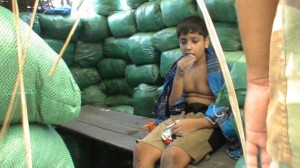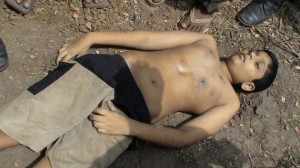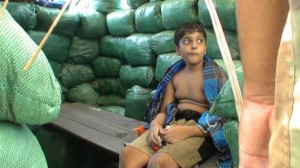
CHILLING DETAILS: Digital image analysis by an expert for Channel 4 has confirmed that these this photograph showing 12-year-old Balachandran Prabakaran before and after he was shot dead, were taken with the same camera.
-
 CHILLING DETAILS: Digital image analysis by an expert for Channel 4 has confirmed that this photograph showing 12-year-old Balachandran Prabakaran after he was shot dead, were taken with the same camera.
CHILLING DETAILS: Digital image analysis by an expert for Channel 4 has confirmed that this photograph showing 12-year-old Balachandran Prabakaran after he was shot dead, were taken with the same camera.CHILLING DETAILS: Digital image analysis by an expert for Channel 4 has confirmed that this photograph showing 12-year-old Balachandran Prabakaran before and after he was shot dead, were taken with the same camera.
New photographs of LTTE chief Velupillai Prabakaran’s son just before he was shot dead, obtained by Channel 4 TV, leave more questions for Sri Lanka to answer about war crimes
It is a war that has produced some truly terrible images, but this one is particularly disturbing. A young boy sits looking distressed, like a child who has been lost in a supermarket. He has been given a biscuit or some kind of snack. In the second photograph, he is looking anxiously up, as though hoping to see someone he recognises.
The boy is Balachandran Prabakaran, the 12-year-old son of Tamil Tiger leader Velupillai Prabakaran.
These photographs, which we are releasing today, form part of the new evidence in the forthcoming feature documentary “No Fire Zone: The Killing Fields of Sri Lanka,” the culmination of three years of research which will be shown for the first time next month in Geneva, to coincide with the U.N. Human Rights Council meeting. The new evidence in the film is certain to increase pressure on the Indian government not only to support a resolution on Sri Lanka and accountability, but also to ensure that it is robustly worded, and that it outlines an effective plan for international action to end impunity in Sri Lanka.
The new photographs tell a chilling story. This child is not been lost of course: he has been captured and is being held in a sandbag bunker, apparently guarded by a Sri Lankan Army soldier. In less than two hours he will be taken, executed in cold blood — and then photographed again.
Forensic pathologist’s opinion
In these photographs, which digital image analysis indicates were taken with the same camera, we can see he has been shot five times in the chest. Separate video footage, also apparently filmed as a war trophy by government soldiers, shows that alongside him lie the bodies of five men. They appear to have been Tamil Tiger fighters, probably his bodyguards. They have been stripped, bound, blindfolded and then shot in the head.
The new photographs are particularly important evidentially, because they prove that Balachandran was not killed in crossfire, or in a battle. His death was deliberate and calculated. The pictures fill in chilling details on the circumstances of his murder — and leave the Sri Lankan government with yet more questions to answer about just how systematic the executions at the end of the war appear to have been. Last year, we first revealed video footage and stills which showed Balachandran’s body shortly after his execution. These were analysed for us by a respected forensic pathologist, Professor Derrick Pounder, to assess the cause of death.
The professor identified what he thinks is the first of the shots to be fired at the boy: “There is a speckling (on the skin) from propellant tattooing, indicating that the distance of the muzzle of the weapon to this boy’s chest was two to three feet or less. He could have reached out with his hand and touched the gun that killed him.”
The professor said the angle of the shots suggested that after that bullet was fired, the boy fell backwards and was then shot four more times. Unlike the men around him, there was no indication that the boy had been blindfolded or bound, so it was possible that the boy may have been made to watch the execution of his guards before the gun was turned on him.
The new photographs released today give us a chilling insight into what happened before that. They appear to demonstrate that the situation was calm and orderly. Balachandran was given a snack and some water. There was time to take photographs while he was held in the bunker and again afterwards. The forensic analysis report on the photographs concludes that there is “no evidence to indicate fabrication, manipulation or the use of effects to create the images” and concludes that the photographs “appear to be an accurate representation of the events depicted.”
From the separate video sequence recorded later (which has also been authenticated by both digital video analysis), it is clear that there were several military personnel in the area.
Where the trail leads to
It is difficult to imagine the mindset of an army in which a child can be executed in cold blood with apparent impunity. It also raises extremely difficult questions for the Sri Lankan military. With every month that passes, the evidence of systematic execution of prisoners grows. The pattern of apparent sexual violence against female fighters is disturbing in the extreme.
As the respected international human rights lawyer, Professor William A. Schabas, says in our film: “If you look at what looks like the mass execution of naked prisoners, these all add up to possibly the claim that this was in fact systematic — and that could point to the highest levels in the military authority of Sri Lanka as being responsible for war crimes of summary execution, killing and torture.”
India’s role
And in Sri Lanka, of course, the highest levels of the military are virtually the same as the highest levels of the government. President Mahinda Rajapaksa and his brother, the Defence Secretary Gotabaya Rajapaksa, have some very difficult questions to answer.
They may well continue to simply deny the evidence and cite the undoubted crimes of the Tamil Tigers. But as a defence, it is becoming increasingly threadbare. The crimes of one side do not justify the crimes of another. A government which claims to adhere to international humanitarian law cannot hide behind the brutal suicide bombings or the brutalised child soldiers of the Tigers. But for India there is a dilemma too. Because it matters not just what the answers to these questions are. It also matters who asks these questions. India is central to this.
It has been said before, but it is true, and worth repeating. Without justice there can be no peace and reconciliation, and without truth there can be no justice.
This is not an academic exercise in historical accountability. The men responsible for these crimes are still in charge. They are continuing to brutally repress Tamils in the north and persecute anyone who criticises the government including, as we have seen with the impeachment of the Chief Justice, their own judiciary.
If there is no attempt to address these issues and to bring justice to those who suffered, the fear is that in the short term, political repression in Sri Lanka will increase and that in the long term, history is destined to repeat itself with yet more bloodshed and regional instability.
It seems to most human rights defenders around the world, including those in India, that the only way ahead in this situation is for the creation of a credible, independent, international inquiry into these events, as called for by the U.N.’s Panel of Experts. That inquiry should examine all the crimes committed by both sides.
If India was to declare its support for such an inquiry, many hope it could mark the start of the long, delayed movement towards peace, reconciliation and political justice in Sri Lanka.
(Callum Macrae is director, “No Fire Zone: The Killing Fields of Sri Lanka.” nofirezone.org. Follow him on Twitter @nofirezonemovie)

